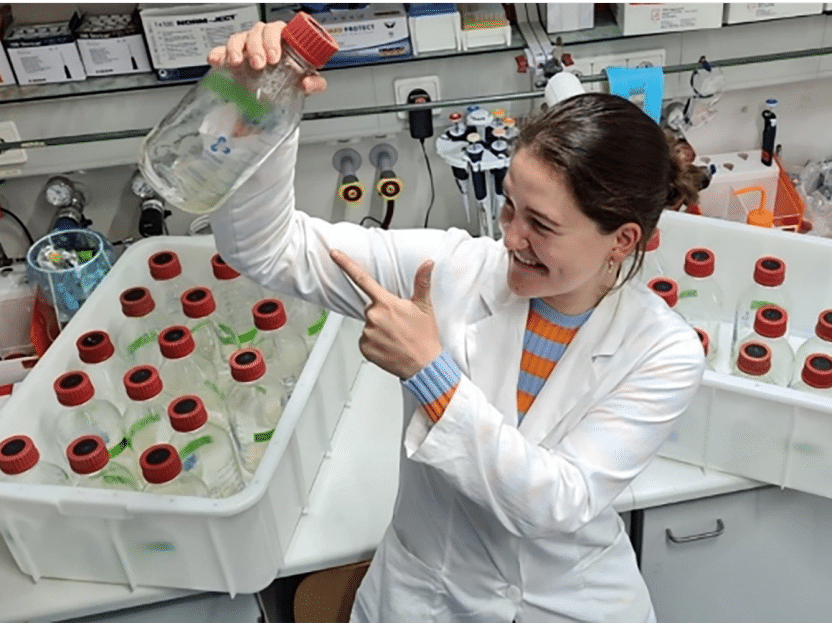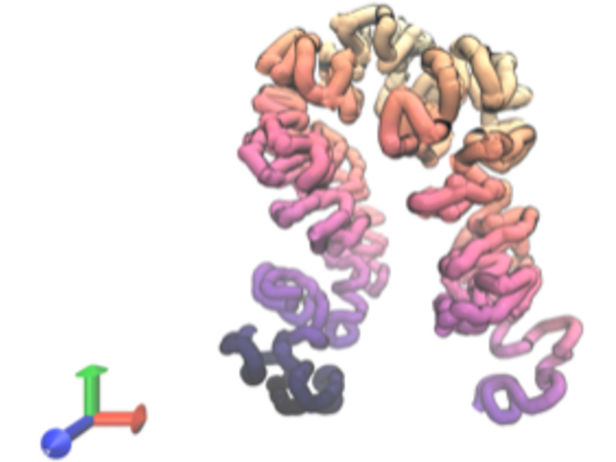Breaking nitrogen while generating methane
Insights into a “hot” microbe that can grow on nitrogen while producing methane
Advertisement
Scientists at the Max Planck Institute for Marine Microbiology have successfully enhanced cultivation of a microorganism that can fix nitrogen (N2) while producing methane (CH4) and ammonia (NH3) and investigated exciting details of its metabolism.

Nevena Maslać with batch cultures of Methanothermococcus thermolithotrophicus in the Microbial Metabolism lab, which allow for precise testing of different growth conditions in complete absence of oxygen.
© Max Planck Institute for Marine Microbiology
Carbon and nitrogen are essential elements of life. Some organisms take up key positions for the cycling of both of them – among them Methanothermococcus thermolithotrophicus. Behind the complicated name hides a complicated microbe. M. thermolithotrophicus is a marine heat-loving methanogen. It lives in ocean sediments, from sandy coasts and salty marshes to the deep-sea, preferably at temperatures around 65 °C. It is able to turn nitrogen (N2) and carbon dioxide (CO2) into ammonia (NH3) and methane (CH4) by using hydrogen (H2). Both products, ammonia and methane, are very interesting for biotechnological applications in fertilizer and biofuels production.
Tristan Wagner and Nevena Maslać from the Max Planck Institute for Marine Microbiology have now managed to grow this microbe in a fermenter – a challenging endeavour. “It is very complicated to provide the perfect conditions for this microbe to thrive while fixing N2 – high temperatures, no oxygen and keeping an eye on hydrogen and carbon dioxide levels”, says Maslać, who carried out the research as part of her PhD project. “But with some ingenuity and perseverance, we managed to make them thrive in our lab and reach the highest cell densities reported so far.” Once the cultures were up and running, the scientists were able to investigate the physiology of the microbe in detail, and later on deepen their study by looking how the metabolism from the microbe adapts to the N2-fixation. “In close collaboration with our colleagues Chandni Sidhu and Hanno Teeling, we combined physiological tests and differential transcriptomics, which allowed us to dig deeper into the metabolism of M. thermolithotrophicus”, Maslać explains.
As improbable as a bumblebee
The metabolic abilities of M. thermolithotrophicus are puzzling: These microbes use methanogenesis, a metabolism that originated on the early anoxic Earth, to acquire their cellular energy. Compared to humans that use oxygen to transform glucose into carbon dioxide, methanogens obtain only a very limited amount of energy from methanogenesis. Paradoxically, fixing nitrogen requires gigantic amounts of energy, which would exhaust them. “They are a bit like bumblebees, which are theoretically too heavy to fly but obviously do so, nevertheless”, says senior author Tristan Wagner, group leader of the Max Planck Research Group Microbial Metabolism. “Despite such energy limitation, these fascinating microbes have even been found to be the prime nitrogen fixers in some environments.”
A robust nitrogenase
The enzyme that organisms use to fix nitrogen is called nitrogenase. Most common nitrogenases require Molybdenum to perform the reaction. Molybdenum nitrogenase is well-studied in bacteria living as symbionts in plant roots. Their nitrogenase can be inhibited by tungstate. Surprisingly, the Bremen scientists found that M. thermolithotrophicus is not disturbed by tungstate while growing on N2. “Our microbe was only dependent on molybdenum to fix N2 and not bothered by tungstate, which implies an adaptation of metal-acquisition systems, making it even more robust for different potential applications”, says Maslać.
Rethinking ammonia production
Nitrogen fixation, i.e., gaining nitrogen from N2, is the major process to insert nitrogen into the biological cycle. For industrial fertilizer production this process is carried out via the Haber-Bosch process, which artificially fixes nitrogen to produce ammonia with hydrogen under high temperatures and pressures. It is used to produce most of the world’s ammonia, an essential fertilizer to sustain global agriculture. The Haber-Bosch process is extremely energy-demanding: It consumes 2% of the world’s energy output, and releasing at the same time up to 1.4% of global carbon emissions. Thus, people are looking for more sustainable alternatives to produce ammonia. “The process used by M. thermolithotrophicus shows that out there in the microbial world there are still solutions that might allow for a more efficient production of ammonia, and that they can even be combined with biofuel production through methane”, says Wagner. “With this study, we understood that under N2-fixing conditions, the methanogen sacrifices its production of proteins to favor nitrogen capture, a particularly smart strategy of energy reallocation”, Wagner sums up. “Our next step will be to move into the molecular details of the process and the enzymes involved, as well as to look into other parts of the organism’s metabolism.”



















































